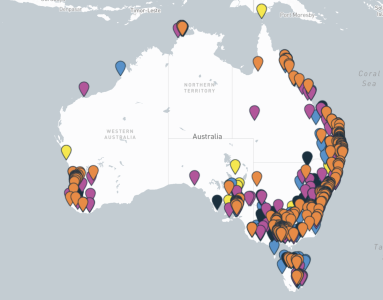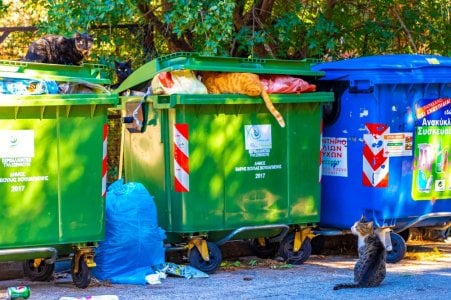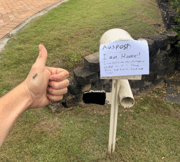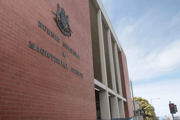‘Causing real pain’: Map shows how Australians are coping with soaring living costs
By
Seia Ibanez
- Replies 11
In a country celebrated for its sun-kissed beaches and laid-back lifestyle, a shadow looms over the everyday lives of Australians as they grapple with a cost of living crisis that is biting into household budgets and forcing difficult choices.
A new map released by advocacy group GetUp! paints a stark picture of the financial pressures Australians face in every corner of the nation, from the bustling cities to the remote outback.
The map, which draws on the responses of nearly 4,000 Australians across all states and territories, is a mosaic of coloured pins, each one representing an individual's primary financial concern.
‘The map shows no matter where people live, no matter what people’s ages are, people are having to make real choices and are feeling a real pain with what’s happening in the grocery stores and through their rent,’ GetUp!’s Chief Campaigns Officer, Amy Gordon, said.
‘(It shows) political inaction on these things is causing real pain.’

The colours range from orange for rent, blue for food, navy for mortgages, yellow for electricity, and purple for other costs.
The survey behind the map found that 89 per cent of Australians are worried about the rising cost of living, with food, energy, health, and housing costs topping the list of concerns.
Rent and mortgage payments, in particular, were the most frequently cited worries.
This concern is underscored by recent Australian Bureau of Statistics (ABS) data, which indicated that the annual inflation rate has climbed to 3.6 per cent in the 12 months to April.
The main drivers of this increase include housing costs, which have risen by 4.9 per cent, and food and non-alcoholic beverages, which have increased by 3.8 per cent.
The rising cost of food is a particularly poignant issue.
The survey highlighted that food and non-alcoholic beverages were among the top two concerns in all states and territories except the Northern Territory.
In the Northern Territory, the focus shifted to health services and energy prices.
Gordon shared troubling anecdotes from the survey from young families and individuals.
‘There were young families having to decide whether they buy fruit and vegetables or whether they go and buy either Hungry Jack’s or McDonald’s because it is just so much cheaper,’ she said.
‘One woman said she actually had to choose between the medicine that she bought for herself for the week and whether she got groceries that week.’
‘These choices are not small choices; they’re life or death choices, and this is what people across the community are having to make.’
‘This is going to have real ramifications on who we are as a society and the healthcare system that we’re going to need.’
The situation has become so dire that some Australians have resorted to 'dumpster diving' to supplement their food supply.
One mother from rural Tasmania named Mandy revealed that she has been scavenging for food in supermarket bins, finding items ranging from meat and milk to gourmet cheese.
‘I was gobsmacked at how much is thrown out by each supermarket per day,’ the mother said.
‘There’s kilos of meat, whole roast, whole chickens, you name it. Eggs, cartons of milk, five-litre bags of brown rice.’
While some of these items are close to their expiry date, others are perfectly edible but discarded due to damaged packaging.
However, Mandy admitted rummaging through bins is not easy.
‘You have to be pretty bolshie. You’re jumping over walls and going right up to where their back doors are,’ she said.
‘Sometimes, the employees will chase you.’
She then called on major supermarkets to create alternative ways for their unwanted products.
‘The meat even could go to the dog homes or the food could go to homeless shelters.
‘There needs to be another way of stopping all of that being thrown out.’
The map and the stories it represents are a call to action for political leaders.
With a federal election on the horizon, GetUp! hopes the map will pressure politicians to address the cost of living crisis and implement real reforms.
‘What this map is trying to do is to show our political leaders across the spectrum that your people in your own community, people who you’re elected to represent, are really feeling the pain, and they’re calling for change,’ Gordon said.
‘They want action on rent, they want action on food, and they want action on energy.’
‘Everyone deserves to be able to afford fresh foods and rent and have a safe place to live,’ she added.
‘Governments have a really important decision to make over the next year.’
 Have you noticed an increase in your grocery bills or utility costs? Have you found creative ways to stretch your dollar further? Let us know in the comments below.
Have you noticed an increase in your grocery bills or utility costs? Have you found creative ways to stretch your dollar further? Let us know in the comments below.
A new map released by advocacy group GetUp! paints a stark picture of the financial pressures Australians face in every corner of the nation, from the bustling cities to the remote outback.
The map, which draws on the responses of nearly 4,000 Australians across all states and territories, is a mosaic of coloured pins, each one representing an individual's primary financial concern.
‘The map shows no matter where people live, no matter what people’s ages are, people are having to make real choices and are feeling a real pain with what’s happening in the grocery stores and through their rent,’ GetUp!’s Chief Campaigns Officer, Amy Gordon, said.
‘(It shows) political inaction on these things is causing real pain.’

GetUp!’s map shows each Australian’s financial concerns during the cost of living crisis. Credit: GetUp!
The colours range from orange for rent, blue for food, navy for mortgages, yellow for electricity, and purple for other costs.
The survey behind the map found that 89 per cent of Australians are worried about the rising cost of living, with food, energy, health, and housing costs topping the list of concerns.
Rent and mortgage payments, in particular, were the most frequently cited worries.
This concern is underscored by recent Australian Bureau of Statistics (ABS) data, which indicated that the annual inflation rate has climbed to 3.6 per cent in the 12 months to April.
The main drivers of this increase include housing costs, which have risen by 4.9 per cent, and food and non-alcoholic beverages, which have increased by 3.8 per cent.
The rising cost of food is a particularly poignant issue.
The survey highlighted that food and non-alcoholic beverages were among the top two concerns in all states and territories except the Northern Territory.
In the Northern Territory, the focus shifted to health services and energy prices.
Gordon shared troubling anecdotes from the survey from young families and individuals.
‘There were young families having to decide whether they buy fruit and vegetables or whether they go and buy either Hungry Jack’s or McDonald’s because it is just so much cheaper,’ she said.
‘One woman said she actually had to choose between the medicine that she bought for herself for the week and whether she got groceries that week.’
‘These choices are not small choices; they’re life or death choices, and this is what people across the community are having to make.’
‘This is going to have real ramifications on who we are as a society and the healthcare system that we’re going to need.’
The situation has become so dire that some Australians have resorted to 'dumpster diving' to supplement their food supply.
One mother from rural Tasmania named Mandy revealed that she has been scavenging for food in supermarket bins, finding items ranging from meat and milk to gourmet cheese.
‘I was gobsmacked at how much is thrown out by each supermarket per day,’ the mother said.
‘There’s kilos of meat, whole roast, whole chickens, you name it. Eggs, cartons of milk, five-litre bags of brown rice.’
While some of these items are close to their expiry date, others are perfectly edible but discarded due to damaged packaging.
However, Mandy admitted rummaging through bins is not easy.
‘You have to be pretty bolshie. You’re jumping over walls and going right up to where their back doors are,’ she said.
‘Sometimes, the employees will chase you.’
She then called on major supermarkets to create alternative ways for their unwanted products.
‘The meat even could go to the dog homes or the food could go to homeless shelters.
‘There needs to be another way of stopping all of that being thrown out.’
The map and the stories it represents are a call to action for political leaders.
With a federal election on the horizon, GetUp! hopes the map will pressure politicians to address the cost of living crisis and implement real reforms.
‘What this map is trying to do is to show our political leaders across the spectrum that your people in your own community, people who you’re elected to represent, are really feeling the pain, and they’re calling for change,’ Gordon said.
‘They want action on rent, they want action on food, and they want action on energy.’
‘Everyone deserves to be able to afford fresh foods and rent and have a safe place to live,’ she added.
‘Governments have a really important decision to make over the next year.’
Key Takeaways
- A new cost of living map, released by advocacy group GetUp!, Aussies are struggling with rising food and energy prices, among other financial burdens.
- The survey indicated that 89 per cent of Australians are worried about the cost of living, with rent, food, energy, health, and mortgages being the primary concerns.
- Some Australians are resorting to measures like 'dumpster diving' to cope with the rising food costs, highlighting the desperate situation some are facing.
- GetUp! is advocating for political action on the cost of living crisis and encouraging policy reforms, such as a rent freeze and measures to combat rising grocery prices, ahead of the upcoming federal election.








